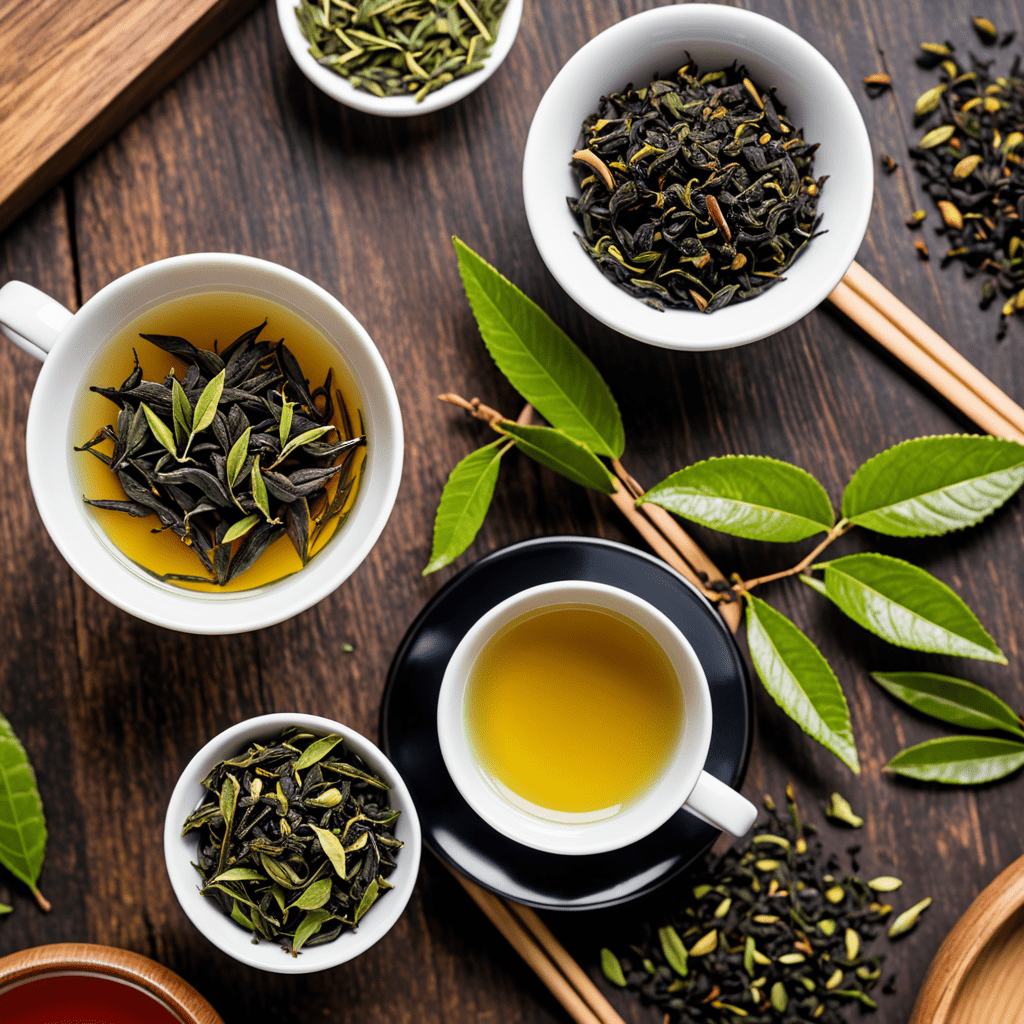The Influence of Climate Change on Indian Tea Production
1. Introduction
India: A Global Tea Giant
India, a land steeped in tradition and renowned for its flavorful teas, holds a prominent position as the world's second-largest tea producer. From the verdant hills of Darjeeling to the lush valleys of Assam, tea plantations flourish, contributing significantly to the country's economy and cultural heritage. However, with the looming threat of climate change, the future of Indian tea production faces significant challenges.
Climate Change: A Growing Concern
Climate change, characterized by rising temperatures, erratic rainfall patterns, and extreme weather events, poses a serious threat to global ecosystems, including agriculture. The delicate balance of factors required for optimal tea cultivation is disrupted by these changes, leading to concerns about the sustainability of this important industry.
Exploring the Impact: The Focus of This Outline
This outline aims to delve into the intricate relationship between climate change and Indian tea production. It will explore the specific ways climate change impacts tea cultivation, analyze its consequences for different tea-growing regions, and highlight the challenges and risks associated with these changes. Additionally, it will examine the adaptation strategies employed by tea growers and the role of technology and government initiatives in mitigating the impact of climate change. Through a comprehensive understanding of these issues, we can work towards ensuring a sustainable future for Indian tea.
2. Climate Change and Its Effects on Tea Cultivation
Understanding Climate Change: A Multifaceted Threat
Climate change encompasses a range of alterations to Earth's climate, including:
- Rising temperatures: Global temperatures are increasing at an alarming rate, with significant consequences for tea cultivation.
- Changing rainfall patterns: Rainfall patterns are becoming more erratic, with both droughts and extreme rainfall events becoming more frequent.
- Extreme weather events: The frequency and intensity of extreme weather events, such as floods, heatwaves, and storms, are on the rise.
Impact on Tea Cultivation: A Delicate Balance Disrupted
These changes can severely affect tea cultivation by:
- Influencing growth: Tea plants thrive within a specific temperature range. Rising temperatures can disrupt growth patterns, impacting yield and quality.
- Yield reduction: Droughts and erratic rainfall can lead to water stress, reducing tea yields and affecting the overall production.
- Quality deterioration: Extreme temperatures and weather events can negatively impact the quality of tea leaves, affecting their taste, aroma, and appearance.
3. Impact on Different Tea Growing Regions
India's Diverse Tea Landscape: A Region-Specific Analysis
India's tea industry is spread across diverse regions, each with its unique climate and challenges:
- Darjeeling: Known for its high-quality teas, Darjeeling is vulnerable to changing rainfall patterns and rising temperatures, leading to concerns about its delicate tea varieties.
- Assam: Assam, the largest tea-producing region, faces challenges from floods and extreme rainfall, which can damage tea bushes and disrupt production.
- Nilgiris: The Nilgiris region is experiencing rising temperatures and changes in rainfall patterns, affecting the growth and quality of tea.
Specific Regional Impacts: Case Studies in Climate Change
Each region experiences climate change differently:
- Darjeeling: Recent droughts have led to reduced yields and concerns about the future of Darjeeling's famed teas.
- Assam: Floods have caused extensive damage to tea plantations in recent years, leading to economic losses and affecting livelihoods.
- Nilgiris: Rising temperatures have altered the growth patterns of tea plants, affecting the timing of harvests and overall production.
6. Role of Technology and Innovation
Embracing Innovation: A Technological Push for Resilience
Technology and innovation play a crucial role in helping Indian tea growers adapt to climate change. These advancements empower growers to mitigate risks, improve efficiency, and enhance sustainability:
- Weather forecasting tools: Accurate weather forecasting systems provide vital information that allows growers to prepare for extreme weather events and adjust their practices accordingly.
- Precision irrigation systems: These systems optimize water usage, ensuring that tea plants receive the appropriate amount of water even during droughts.
- Disease-resistant tea varieties: Scientists are developing tea varieties that are resistant to diseases that thrive in warmer temperatures and changing rainfall patterns.
- Smart sensors: These sensors monitor soil moisture, temperature, and other environmental factors, providing real-time data that guides decision-making.
7. Government Policies and Initiatives
A Supportive Hand: Government Interventions for a Sustainable Future
The Indian government recognizes the importance of supporting the tea industry in adapting to climate change. Various policies and initiatives have been implemented to facilitate this transition:
- Subsidies for climate-resilient tea varieties: The government provides financial assistance to tea growers for adopting disease-resistant and drought-tolerant tea varieties.
- Promotion of sustainable farming practices: Programs are in place to encourage the adoption of sustainable farming practices, such as organic farming and water conservation techniques.
- Climate change adaptation research: The government funds research initiatives focused on developing climate-resilient tea cultivation practices and technologies.
- Building capacity and awareness: Training programs and workshops are conducted to educate tea growers about climate change adaptation strategies and best practices.
8. Conclusion
A Future of Adaptation and Resilience
Climate change presents a significant challenge to Indian tea production, but it is not an insurmountable one. By embracing adaptation strategies, leveraging technology and innovation, and working collaboratively with the government, the Indian tea industry can mitigate the negative impacts of climate change and secure a sustainable future. Through proactive measures and a commitment to innovation, Indian tea can continue to delight palates and contribute to the socio-economic landscape for generations to come.
9. Recommendations
A Call to Action: Embracing a Sustainable Future for Indian Tea
In light of the challenges posed by climate change, several recommendations can be made to ensure the sustainability of Indian tea production:
- Continued investment in research and development: Research into climate-resilient tea varieties, sustainable farming practices, and adaptation technologies should be prioritized.
- Enhanced collaboration between stakeholders: Collaboration between tea growers, government agencies, researchers, and industry experts is crucial to develop and implement effective adaptation strategies.
- Increased awareness and education: Tea growers must be educated about climate change adaptation strategies and best practices to ensure widespread adoption.
- Financial support for adaptation: The government and other organizations should provide financial assistance to tea growers to facilitate the adoption of climate-resilient practices and technologies.
- Promotion of sustainable tea consumption: Consumers can play a role by choosing sustainably produced teas and supporting responsible tea companies.
10. Frequently Asked Questions (FAQs)
Addressing Common Concerns about Climate Change and Indian Tea
1. How will climate change affect the taste and quality of Indian tea?
Climate change can impact the taste and quality of Indian tea by altering the growing conditions of tea plants. Rising temperatures and changing rainfall patterns can affect the chemical composition of tea leaves, potentially influencing their flavor, aroma, and appearance.
2. What are the most vulnerable tea-growing regions in India?
Darjeeling, Assam, and the Nilgiris are among the most vulnerable tea-growing regions in India due to their unique climatic conditions and susceptibility to extreme weather events.
3. What can consumers do to support sustainable tea production in India?
Consumers can support sustainable tea production by choosing teas that are certified organic, Fairtrade, or Rainforest Alliance. They can also look for tea companies that are actively implementing climate-resilient practices and supporting tea growers in adapting to climate change.
4. What role can technology play in mitigating the impact of climate change on Indian tea production?
Technology can play a significant role in mitigating the impact of climate change by providing tools for accurate weather forecasting, precision irrigation, disease monitoring, and data-driven decision-making.
5. What are the government's plans to support the tea industry in adapting to climate change?
The Indian government has implemented various policies and initiatives to support the tea industry in adapting to climate change. These include subsidies for climate-resilient tea varieties, promotion of sustainable farming practices, and funding for climate change adaptation research.



